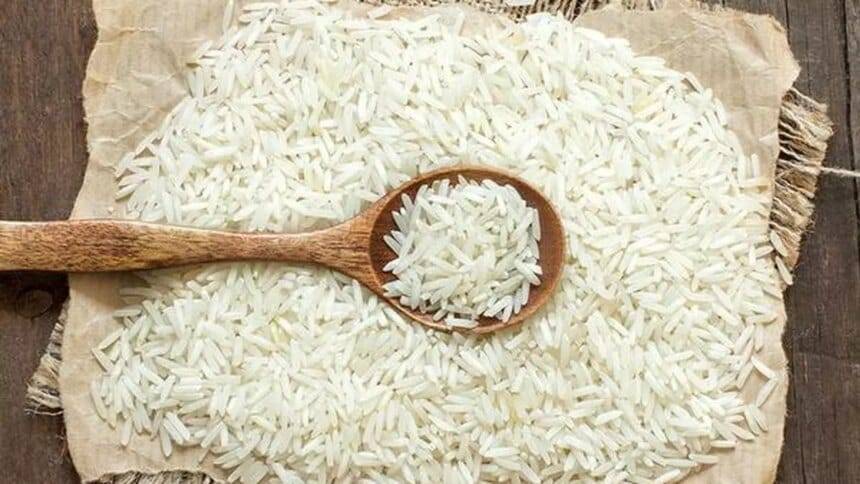Main Points In Hindi (मुख्य बातें – हिंदी में)
-
चावल निर्यात की स्थिति: भारत 2023-2024 में 16.5 मिलियन टन चावल का निर्यात करेगा, जिसमें बासमती चावल की मात्रा 5.24 मिलियन टन है, जो पिछले वर्ष से 15% अधिक है। बासमती चावल की अनूठी सुगंध और लंबे दाने इसे वैश्विक चावल बाजार में एक महत्वपूर्ण उत्पाद बनाते हैं।
-
किसानों की आजीविका: बासमती चावल मुख्यतः पंजाब, हरियाणा और उत्तर प्रदेश के किसान समुदाय के लिए वित्तीय स्थिरता का स्रोत है। हालांकि, इन किसानों को बीमा जटिलताओं और व्यापार बाधाओं जैसी चुनौतियों का सामना करना पड़ता है।
-
बढ़ती वैश्विक मांग: बासमती चावल के निर्यात में वृद्धि इसके लिए बढ़ती वैश्विक मांग का संकेत है, खासकर मध्य पूर्व के देशों जैसे सऊदी अरब और इराक में, जहां भारतीय प्रवासियों के संस्कृतियों और पकवानों की लोकप्रियता है।
-
बीमा और व्यापार बाधाएँ: निर्यातकों को उच्च प्रीमियम, सीमित बीमा विकल्प, और जटिल व्यापार नियमों जैसी समस्याओं का सामना करना पड़ता है। ये बाधाएँ भारतीय बासमती चावल की वैश्विक प्रतियोगिता को प्रभावित कर सकती हैं।
- सुधार की संभावनाएँ: बासमती चावल के निर्यात को बढ़ाने के लिए सरकार और निजी कंपनियों के बीच सहयोग की आवश्यकता है। बेहतर बीमा उत्पाद विकसित करने, टैक्स में छूट, और बुनियादी ढांचे में सुधार से निर्यात प्रक्रियाओं को सुगम बनाने का सुझाव दिया गया है।
Main Points In English(मुख्य बातें – अंग्रेज़ी में)
Here are the main points from the article regarding India’s basmati rice export situation:
-
Export Growth: India is projected to export 16.5 million tons of rice, including 5.24 million tons of basmati rice for the 2023-2024 period, marking a 15% increase from the previous year. Basmati rice is well-regarded for its unique aroma, delicate flavor, and long grains.
-
Importance for Farmers: Basmati rice cultivation is crucial for farmers in northern Indian states like Punjab, Haryana, and Uttar Pradesh, significantly contributing to the country’s agricultural exports. Despite growth, these regions face challenges such as complex insurance issues and trade barriers.
-
Rising Global Demand: The increase in basmati rice exports is driven by strong global demand, particularly from the Middle East, where cultural ties and a preference for Indian cuisine foster a substantial market for such rice.
-
Insurance and Trade Challenges: Exporters encounter multiple challenges, including complex insurance landscapes leading to difficulties in securing adequate coverage for transportation risks, theft, spoilage, and price fluctuations. Additionally, stringent quality and safety regulations in importing countries can hamper export processes.
- Strategic Solutions for Sustainable Growth: To address these challenges, strategic measures including tailored insurance products, improved diplomatic relations for trade facilitation, and investments in logistics and regulatory compliance simplification are essential. Enhancing awareness and marketing of basmati rice’s unique qualities can also help boost its demand in global markets.


Complete News In Hindi(पूरी खबर – हिंदी में)
2023-2024 तक, भारत में दुनिया का सबसे अधिक चावल निर्यात मात्रा 16.5 मिलियन टन है, जिसमें बासमती चावल 5.24 मिलियन टन है, जो पिछले वर्ष से 15 प्रतिशत अधिक है। भारत का बासमती चावल लंबे समय से अपनी अनूठी सुगंध, नाजुक स्वाद और लंबे दाने के लिए जाना जाता है। चावल की यह प्रीमियम किस्म न केवल भारतीय व्यंजनों का प्रमुख हिस्सा है, बल्कि वैश्विक चावल बाजार में भी एक महत्वपूर्ण खिलाड़ी है।
यह चावल भारत के उत्तरी राज्यों जैसे पंजाब, हरियाणा और उत्तर प्रदेश में किसानों की आजीविका के लिए महत्वपूर्ण है, जो देश के कृषि निर्यात में महत्वपूर्ण योगदान देते हैं। हालाँकि इस क्षेत्र में पर्याप्त वृद्धि देखी गई है, लेकिन इसे बीमा जटिलताओं और व्यापार बाधाओं सहित कई चुनौतियों का भी सामना करना पड़ रहा है, जो इसके भविष्य के विकास और बाजार की स्थिति को प्रभावित करते हैं।
बढ़ती मांग
बासमती चावल के निर्यात में वृद्धि इस प्रीमियम उत्पाद की बढ़ती वैश्विक मांग को उजागर करती है। इस महत्वपूर्ण बाजार में उच्च गुणवत्ता वाले चावल के लिए एक मजबूत भूख है, जो स्थानीय उपभोग की जरूरतों और प्रामाणिक भारतीय व्यंजनों के लिए भारतीय प्रवासियों की प्राथमिकता दोनों से प्रेरित है। उदाहरण के लिए, मध्य पूर्व अपने सांस्कृतिक संबंधों और पारंपरिक भारतीय व्यंजनों की मांग के कारण लंबे समय से एक महत्वपूर्ण बाजार रहा है, जिसमें प्रमुख रूप से बासमती चावल शामिल है।
-
यह भी पढ़ें: दक्षिण-पूर्व एशिया में बासमती चावल का निर्यात: भारतीय निर्यातकों के लिए चुनौती या अवसर?
इसी तरह, कृषि और प्रसंस्कृत खाद्य उत्पाद निर्यात विकास प्राधिकरण (एपीडा) के अनुसार, भारत ने 2023-2024 में ₹48,389.18 करोड़ में 5.2 मिलियन टन बासमती चावल का निर्यात किया। भारतीय बासमती चावल के प्रमुख निर्यात स्थलों में सऊदी अरब, इराक, ईरान, संयुक्त अरब अमीरात, संयुक्त राज्य अमेरिका और यमन शामिल हैं, जो भारत के कृषि निर्यात की लचीलापन और क्षमता को प्रदर्शित करते हैं।
बीमा चुनौतियाँ
हालाँकि, जैसे-जैसे निर्यात की मात्रा बढ़ती है, निर्यातकों को कई चुनौतियों का सामना करना पड़ता है जो इस उर्ध्वगामी प्रक्षेपवक्र को बनाए रखने की उनकी क्षमता में बाधा बन सकती हैं। एक महत्वपूर्ण मुद्दा बासमती चावल निर्यात से जुड़ा बीमा परिदृश्य है, जो तेजी से जटिल हो गया है। निर्यातकों के लिए बीमा एक महत्वपूर्ण घटक है, खासकर अस्थिर वैश्विक बाजार में।
बासमती चावल के निर्यातकों को अक्सर परिवहन, चोरी, खराब होने और कीमत में उतार-चढ़ाव सहित विभिन्न जोखिमों का सामना करना पड़ता है। उच्च प्रीमियम, सीमित कवरेज विकल्प और जटिल दावा प्रक्रिया के कारण पर्याप्त बीमा कवरेज सुरक्षित करना चुनौतीपूर्ण हो सकता है। ये बीमा चुनौतियाँ संभावित निर्यातकों को बासमती चावल व्यापार में शामिल होने से रोक सकती हैं या उनके संचालन के दायरे को सीमित कर सकती हैं, जो अंततः भारत की निर्यात क्षमता को प्रभावित कर सकती हैं।
व्यापार बाधाएं निर्यात को प्रभावित कर रही हैं
बीमा मुद्दों के अलावा, विभिन्न व्यापार बाधाएँ भारतीय बासमती चावल निर्यात परिदृश्य पर महत्वपूर्ण प्रभाव डालती हैं। कई आयातक देश बासमती चावल सहित खाद्य उत्पादों पर कड़े गुणवत्ता और सुरक्षा नियम लागू करते हैं। इन विनियमों के अनुपालन के लिए अक्सर अतिरिक्त प्रमाणपत्र और परीक्षण की आवश्यकता होती है, जो निर्यातकों के लिए महंगा और समय लेने वाला हो सकता है। साथ ही, आयातक देशों द्वारा लगाए गए व्यापार शुल्क भारतीय बासमती चावल को वैश्विक बाजार में कम प्रतिस्पर्धी बना सकते हैं। कुछ देश चावल के आयात पर उच्च शुल्क लगा सकते हैं, जिससे संभावित खरीदार भारत से बासमती खरीदने से हतोत्साहित हो सकते हैं। भूराजनीतिक तनाव और राजनयिक संबंध भी व्यापार की गतिशीलता को प्रभावित कर सकते हैं, जिससे व्यापार नीतियों या प्रतिबंधों में अचानक बदलाव हो सकते हैं।
इसके अतिरिक्त, सितंबर 2024 में, भारत सरकार ने न्यूनतम निर्यात मूल्य (एमईपी) को हटाकर बासमती चावल के निर्यात को बढ़ाने के लिए एक महत्वपूर्ण कदम उठाया। इस निर्णय का उद्देश्य भारतीय बासमती को वैश्विक बाजारों में अधिक प्रतिस्पर्धी बनाना है, जिससे संभावित रूप से निर्यात मात्रा और राजस्व में वृद्धि होगी।
सतत विकास के लिए रणनीतियाँ
इन चुनौतियों से पार पाने के लिए कई रणनीतिक उपाय लागू किए जा सकते हैं। कृषि निर्यातकों की आवश्यकताओं के अनुरूप विशेष बीमा उत्पाद विकसित करने से जोखिमों को कम करने और लागत कम करने में मदद मिल सकती है। सरकारी निकायों, बीमा कंपनियों और निर्यातकों के बीच सहयोग अधिक व्यापक कवरेज का मार्ग प्रशस्त कर सकता है। भारत सरकार निष्पक्ष व्यापार प्रथाओं की वकालत करने, टैरिफ कम करने और प्रमुख आयातक देशों के साथ संबंधों को मजबूत करने के लिए राजनयिक प्रयासों में शामिल होकर भी महत्वपूर्ण भूमिका निभा सकती है।
-
यह भी पढ़ें: भारत ने चावल निर्यात प्रतिबंधों को और कम करने का निर्णय लिया
इसके अतिरिक्त, निर्यातकों के लिए नियामक अनुपालन को सरल बनाने से अधिक व्यवसायों को बासमती चावल व्यापार में शामिल होने के लिए प्रोत्साहित किया जा सकता है। लॉजिस्टिक्स और परिवहन बुनियादी ढांचे को बढ़ाने से निर्यात प्रक्रियाओं को आसान बनाया जा सकता है। कोल्ड स्टोरेज सुविधाओं, परिवहन नेटवर्क और बंदरगाह सुविधाओं में निवेश से बासमती चावल निर्यात की दक्षता में काफी सुधार हो सकता है। अंततः, वैश्विक बाजारों में भारतीय बासमती चावल की गुणवत्ता और विशिष्टता के बारे में जागरूकता बढ़ने से मांग बढ़ सकती है। सुगंध, बनावट और स्वाद जैसी विशिष्ट विशेषताओं को उजागर करने वाले लक्षित विपणन अभियान नए उपभोक्ताओं को आकर्षित कर सकते हैं।
जबकि भारतीय बासमती चावल निर्यात का भविष्य बढ़ती शिपमेंट मात्रा और बढ़ती मांग के साथ आशाजनक लग रहा है, बीमा मुद्दों और व्यापार बाधाओं की अंतर्निहित चुनौतियों को संबोधित करना निरंतर विकास के लिए महत्वपूर्ण है। रणनीतिक उपायों को अपनाकर और हितधारकों के बीच सहयोग को बढ़ावा देकर, भारत बासमती चावल के एक प्रमुख निर्यातक के रूप में अपनी स्थिति को मजबूत कर सकता है, यह सुनिश्चित करते हुए कि यह प्रतिष्ठित उत्पाद अंतरराष्ट्रीय बाजारों में बढ़ता रहेगा।
लेखक डीआरआरके फूड्स के संयुक्त प्रबंध निदेशक हैं
Complete News In English(पूरी खबर – अंग्रेज़ी में)
As of 2023-2024, India has the highest rice export volume in the world at 16.5 million tons, with basmati rice accounting for 5.24 million tons, which is a 15% increase from the previous year. Indian basmati rice is known for its unique aroma, delicate taste, and long grains. This premium variety of rice is not only a staple in Indian cuisine but also plays a significant role in the global rice market.
This rice is crucial for farmers’ livelihoods in the northern states of India, such as Punjab, Haryana, and Uttar Pradesh, contributing significantly to the country’s agricultural exports. While this sector has seen substantial growth, it faces challenges such as insurance complexities and trade barriers, which affect its future growth and market status.
Growing Demand
The increase in basmati rice exports highlights the rising global demand for this premium product. There is a strong appetite for high-quality rice in the market, driven by local consumption needs and the preferences of Indian expatriates for authentic Indian dishes. For instance, the Middle East has long been a key market due to cultural ties and the demand for traditional Indian cuisine, including basmati rice.
- Read more: Basmati Rice Exports in Southeast Asia: Challenge or Opportunity for Indian Exporters?
According to the Agricultural and Processed Food Products Export Development Authority (APEDA), India exported 5.2 million tons of basmati rice worth ₹48,389.18 crore in 2023-2024. Major export destinations for Indian basmati rice include Saudi Arabia, Iraq, Iran, the United Arab Emirates, the United States, and Yemen, demonstrating India’s agricultural export resilience and capacity.
Insurance Challenges
However, as export volumes increase, exporters face several challenges that may hinder their ability to maintain this upward trajectory. A significant issue is the increasingly complex insurance environment related to basmati rice exports. Insurance is a crucial element for exporters, especially in a volatile global market.
Basmati rice exporters often encounter various risks, including transportation issues, theft, spoilage, and price fluctuations. Securing adequate insurance coverage can be challenging due to high premiums, limited coverage options, and complicated claims processes. These insurance challenges may deter potential exporters from engaging in the basmati rice trade or limit their operational scope, ultimately impacting India’s export potential.
Trade Barriers Affecting Exports
In addition to insurance issues, various trade barriers significantly affect the landscape of Indian basmati rice exports. Many importing countries implement strict quality and safety regulations for food products, including basmati rice. Compliance with these regulations often requires additional certifications and testing, which can be costly and time-consuming for exporters. Furthermore, trade tariffs imposed by importing countries can make Indian basmati rice less competitive in the global market. Some countries may impose high tariffs on rice imports, discouraging potential buyers from purchasing basmati rice from India. Geopolitical tensions and diplomatic relationships can also influence trade dynamics, leading to sudden changes in trade policies or restrictions.
Additionally, in September 2024, the Indian government took a significant step to boost basmati rice exports by removing the Minimum Export Price (MEP). This decision aims to make Indian basmati more competitive in global markets, potentially increasing export volume and revenue.
Strategies for Sustainable Development
To overcome these challenges, several strategic measures can be implemented. Developing specialized insurance products tailored to the needs of agricultural exporters can help mitigate risks and reduce costs. Collaboration between government agencies, insurance companies, and exporters can lead to more comprehensive coverage. The Indian government can also play a vital role by promoting fair trade practices, reducing tariffs, and strengthening relationships with major importing countries through diplomatic efforts.
- Read more: India Decides to Further Ease Rice Export Restrictions
Moreover, simplifying regulatory compliance for exporters can encourage more businesses to participate in the basmati rice trade. Improving logistics and transportation infrastructure can streamline export processes. Investments in cold storage facilities, transportation networks, and port facilities can significantly enhance the efficiency of basmati rice exports. Ultimately, raising awareness of the quality and uniqueness of Indian basmati rice in global markets can drive demand. Targeted marketing campaigns highlighting distinctive features like aroma, texture, and flavor can attract new consumers.
While the future of Indian basmati rice exports appears promising, with increasing shipment volumes and growing demand, addressing underlying challenges related to insurance issues and trade barriers is crucial for sustainable development. By adopting strategic measures and fostering collaboration among stakeholders, India can strengthen its position as a leading exporter of basmati rice, ensuring this prestigious product continues to thrive in international markets.
The author is the Joint Managing Director of DRRK Foods




